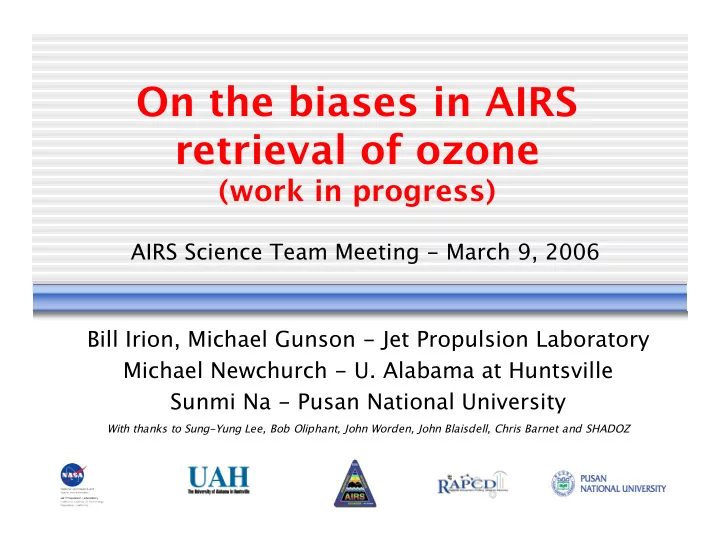

On the biases in AIRS retrieval of ozone (work in progress) AIRS Science Team Meeting - March 9, 2006 Bill Irion, Michael Gunson - Jet Propulsion Laboratory Michael Newchurch - U. Alabama at Huntsville Sunmi Na - Pusan National University With thanks to Sung-Yung Lee, Bob Oliphant, John Worden, John Blaisdell, Chris Barnet and SHADOZ 1
AIRS captures UTLS ozone events May 21/2005 270 mb AIRS-TES relative difference Filled dots are TES observations 300 (AIRS - TES) / TES (%) -100 300 10 -8 10 -7 10 -6 -100 TES O 3 VMR AIRS AIRS in qualitative agreement with TES TES in ozone regions > 100ppb. (filled dots) 100 300 600 O 3 vmr (pptv) 2
Simplified AIRS retrieval of ozone L1B AIRS 3x3 Channel golfball obs. + selection AMSU Cloud- Cloud Ozone cleared (Constrained) profiles radiances Clearing Physical and errors and Retrieval Cloud-cleared columns radiances First guess Regression Damping parameter Training by (“noise propagation ECMWF ozone threshold”) 3
How much is AIRS getting its skill in ozone from regression? …biases are similar to ECMWF. Relative di ff erences of AIRS & ECMWF vs ozonesondes Correction: matchup is within 100 km and 6 hrs. ECMWF/Sonde AIRS/Sonde Standard deviations shown. Pressures offset for clarity. Like ECMWF, AIRS is too high in troposphere and too low in stratosphere; column OK. 4
How does channel selection and damping a ff ect the retrieval? L1B AIRS 3x3 Channel golfball obs. + selection AMSU Cloud- Cloud Ozone cleared (Constrained) profiles radiances Clearing Physical and errors and Retrieval Cloud-cleared columns radiances First guess Regression Damping parameter Training by (“noise propagation ECMWF ozone threshold”) 5
Decreasing damping worsens results in upper trop/lower strat with current channel selection AIRS - Sonde Average Sonde Less damping Matchups within 100 km and 3 hrs of sonde launch Current damping -1 2 -1 2 Error bars are std. dev. 6
If results worse with decreased damping, let’s give the retrieval more information O 3 , CO 2 and H 2 O line strengths, frequencies and O 3 retrieval channels ad hoc selection 7
Adding channels at current damping doesn’t change anything. Average AIRS - Sonde Sonde Error bars are std. dev. 8
Adding channels and decreasing damping gives mixed results Less Average damping and more channels AIRS - Sonde Sonde Better Worse Better Worse Worse Error bars are std. dev. Current Pressures offset for clarity damping & Better Better Better current Better channels 9 Point: there’s some tradespace with decreased damping and additional channels.
Let’s look at the radiances and their uncertainties… L1B AIRS 3x3 Channel golfball obs. + selection AMSU Cloud- Cloud Ozone cleared (Constrained) profiles radiances Clearing Physical and errors and Retrieval Cloud-cleared columns radiances First guess Regression Damping parameter Training by (“noise propagation ECMWF ozone threshold”) 10
^2 We need reliable errors in cloud-cleared radiances! 2 If χ >> 1, bad fits or underestimating noise � � 1 obs i � calc i N � � = Goodness of fit diagnostic � � If χ << 1, fitting noise or overestimating noise N NESR i i = 1 � � Cloud-cleared radiance error 9/6/2002 granule 176 geoTrack 3, geoXTrack 23 geoTrack 2, geoXTrack 27 geoTrack 21, geoXTrack 5 Black marks = (obs - calc) in BT Red line = radiance error in obs BT for O 3 channels only 10 1 1 -10 -1 -1 χ = 2.33 χ = 0.28 χ = 1.03 Error too low? Error too high? Error about right? Overly high error in cloud-cleared spectral radiance helps drive over-constraint of retrieval. 11 Overly low errors help drive an under-constraint.
Systematic biases in radiance uncertainties? χ vs mean BT error in ozone channels Sept 6/02 V4 100 100 Granule 176 Qual_O3 = 0 Qual_surf = 0 10 (mostly ocean off US Northeast) 10 2 � � χ 1 obs i � calc i N 1 � � = � � NESR i N i = 1 � � 1 0.1 χ vs BT error should be a horizontal line at χ =1 ! If χ >> 1, bad fits or underestimating noise 0.01 0.1 0.01 100 0.01 10 If χ << 1, fitting noise or overestimating noise Mean BT error in ozone channels (K) The biggest problem with ozone may not be in the regression or the physical retrieval, but in the cloud-clearing. 12
Summary Suboptimal channel selection? Incorrect Cloud uncertainties in 10 µ m Ozone Physical Clearing Retrieval band profile often too radiances Retrieval constrained biases ECMWF O 3 biases in first guess Regression Damping parameter set too tightly? Work in progress. Note that for the moment I’m not taking into account trapezoids, biases in the spectroscopy, etc. 13
Thanks for your time! Retrieval Damping Squad 14
Surface Temperature Qual_surf = 0 χ Mean BT error in fitted channels (K) 15
Temperature Profile Qual_surf = 0 χ Mean BT error in fitted channels (K) 16
χ vs Brightness Temperature Error Optimal Estimation Retrieval 2 If χ >> 1, bad fits or underestimating noise � � 1 obs i � calc i N � � = � � If χ << 1, fitting noise or overestimating noise N NESR i i = 1 � � 17
Recommend
More recommend